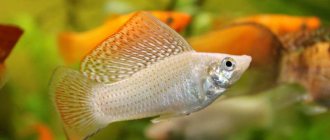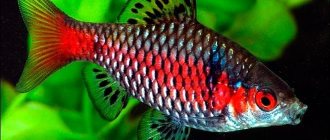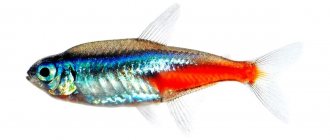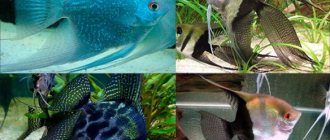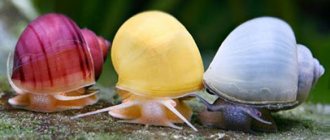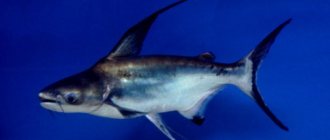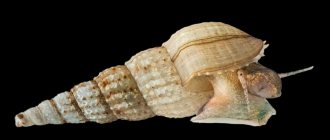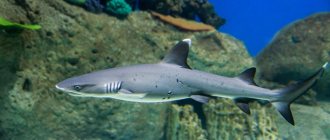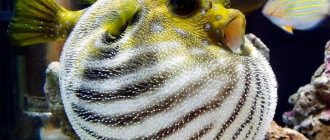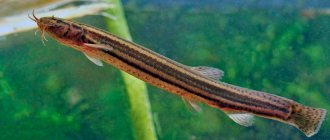5
(7)
Thanks to its endurance, interesting behavior and unpretentiousness in keeping, the Lineatus pike has become popular in the world aquarium hobby. The first scientific description dates back to 1846. At the beginning of the 20th century, the species appeared in German aquariums, where the experience of breeding at home was first established.
Description
The golden lineatus is a small fish that grows up to 10 cm in length and can live in an aquarium for up to 4 years.
The body is elongated and slender, with a slightly stooped back. The head is flattened at the top, with a pointed muzzle and mouth turned upward.
The natural color is much more faded compared to the one that gave lineatus its popularity - golden (gold form).
This color, of course, does not occur in nature; a fish so bright simply cannot live long. But, in general, in terms of maintenance and care, such fish do not differ from those painted in natural colors.
The body is bronze with small bronze scales, and closer to the tail there are several dark vertical stripes. But, using the method of selection, it was bred to look like the fish we know now - golden in color.
Appearance and gender differences.
Lineatus in appearance resembles a small pike, only it is up to 10 cm long, has a flat body, turning into a head with an elongated large mouth. The eyes are large, green, and the fins have the same arrangement as large pikes. The color of the male's body is yellowish-brown, and the body is decorated with rows of golden-green dots. The chest is dotted with red specks. The fins are decorated with golden dots and streaks. Thoracic and abdominal are yellow. The golden and green forms of lineatus are also distinguished. According to sexual differences, females are larger than males, and the color is not so bright; females have a dark spot on the dorsal fin. Upon reaching sexual age, breeders should develop dark transverse stripes on the back half of the body.
Asian pike
DESCRIPTION
The homeland of these fish is Southeast Asia, where they inhabit fresh water reservoirs. These fish were brought to Russia in 1903. Today they contain four species of Asian pike.
Difficulty in content
A very hardy fish, with a high degree of adaptation to conditions in the aquarium. Most killfish are not suitable for beginners, but lineatus pike are an exception to the rule.
She is not whimsical, eats a variety of foods and can live in very different conditions. Another plus is that they are quite easy to breed.
This is a very unpretentious species and is easy to maintain. But, despite its small size, it is a predator, and the lineatus pike will tirelessly hunt small fish, such as neon and zebrafish.
They must be kept with fish that are equal in size or larger.
General information
Lineatus is a small-sized tropical fish from the Aplocheilidae family, a typical representative of spawning carp-toothed fish. Among aquarists, other names have taken root, for example, such as: aquarium pike or Asian pike. Indeed, her elongated body is similar to the body of a river predator.
In 1846, the first scientific description of lineatus was made. Half a century later, the fish came to Germany. Local residents not only found a common language with the exotic pet, but also created suitable conditions for its reproduction at home.
Natural species have a not too bright body color: vertical stripes run along the body with a bronze tint, and red fins are located on top of the back.
Keeping in an aquarium
An unpretentious fish that spends most of its time in the upper layers of water.
The recommended keeping volume is 80 liters, but they live quite calmly in smaller aquariums. An aquarium with lineatuses must be covered, as they can jump out of the water.
Since in nature they live in both brackish and fresh water, the water can be slightly salted, although you can do without it.
Pike is undemanding to water parameters, but it is advisable to maintain: temperature 23-25°C, ph: 6.0-7.5, and hardness 5 - 20 dGH. Water changes and soil siphoning are also required; filtration is desirable, but you can do without it.
Pike look best in an aquarium that imitates their native habitat. Dark soil and dim light will show the beauty of their coloring to the fullest.
Since fish spend most of their time in the upper layers of water, it is better to put floating plants, such as pistia, on the surface so that they can hide among its roots. You can also use tall plants that spread along the surface of the water.
Nothobranchius
This seasonal Killi Fish lives for about 12 months. To maintain the population, they need to be constantly bred. The fish get along well with other aquarium mates.
Nothobranchius prefer to swim on the surface or in the middle layers of the aquarium world. A deep and richly planted aquaworld is most suitable for them. Small “fights” between males may occur.
Nothobranchiuses are distinguished by their brightly colored scales. Among them there are individuals with a predominance of turquoise, red, green or purple colors.
Pike feed exclusively on live and frozen food. The most optimal water temperature in the aquarium for nothobranchius is 22–25 degrees.
Compatibility
Peaceful predators do not touch other fish, provided that they are large enough not to be considered as prey. They can arrange small skirmishes among themselves; it is better to keep at least 4 individuals.
However, skirmishes do not harm the fish. Well suited for keeping with fish of the same size, but what you should avoid are small fish.
For example, they will consider zebrafish, cardinals, rasbora, microrasbora galaxy and neons as food.
Habitat
Widely distributed throughout the Hindustan Peninsula (the territory of modern India). They prefer all types of reservoirs with slow flow or standing water, including brackish ones. Unlike most other species in this region, the Asian striped pike does not migrate, but constantly lives in its range. In a number of areas of India and neighboring countries, they are used by local authorities as a means of controlling mosquitoes. They feed on insect larvae, small aquatic insects, crustaceans, river worms, and small fish. The golden breeding form is not found in the wild.
Breeding
Pike are bred quite simply. During spawning, which can last daily for a week or more, the pair lays 50 to 300 eggs daily on small-leaved plants or cleared surfaces.
The thickets of plants on which they lay eggs must be replaced daily with others. This could be a bunch of moss that needs to be moved to an aquarium with the same water parameters as in the spawning tank.
The fry fully develops within 12-14 days. First, a larva appears, which consumes the contents of its yolk sac for a long time, and then begins to swim and feed.
Artemia nauplii starter food or egg yolk. Some fry grow faster and may eat their brothers, so they need to be sorted.
Feeding your pet
The carp-tooth has a developed jaw. He willingly eats:
If you introduce fry into the aquarium and do not give other food, it will feed on them. Pike respond well to dry food. You can give her cereal. In order for a freshwater resident to receive valuable substances, you need to feed it with crushed bloodworms .
Lineatus is prone to gluttony, so you should give him food in moderation.
Common pike
This is the most common species of predatory fish that can live in aquariums. In freedom it reaches 120 cm, and in captivity it is small - about 60 cm.
The fish has hard, armor-like scales, which is why it is also called armored pike. The predator's body is elongated, with sharp teeth on its powerful jaws. A distinctive feature is the vertebrae, which have a depression on only one side. The opposite side is convex, like that of amphibians. Breathing occurs through the swim bladder.
When keeping, the most important thing is the water temperature, which should not exceed 18-20 degrees, otherwise the fish may die.
You cannot keep armored fish in aquariums smaller than 150 liters. This leads to the fact that the individual begins to gain weight and its size decreases.
Definition of disease
Exophthalmos is considered a syndrome characterized by forward displacement of the eyeball. Experts identify several types of such pathology, taking into account the reason that provoked it. Treatment of bulging eyes involves an integrated approach and is carried out under the supervision of various specialists.
Exophthalmos develops as a consequence of various pathological processes, endocrine disorders, neoplasms of various types and brain thrombosis. Studies have shown that most often exophthalmos of endocrine etiology occurs in women, and post-traumatic protrusion of the eyes is diagnosed in men.
Pathology can develop at any age in both children and adults. Exophthalmos can affect one organ of vision or both at once. Most often, in case of eye pathologies, unilateral exophthalmos is diagnosed, and bilateral exophthalmos is mainly a sign of malfunction of the thyroid gland. Protrusion of the eyeball can be either barely noticeable or quite severe.
Limnophila sessile-floral
sessile flowering
Limnophila sessile-flowered or “dwarf” is much less common, but is not inferior in its elegance to other species. In aquariums, this plant is planted in bunches in the far corners. Limnophila sessile-flowered is quite sensitive to the size of the container, so a spacious and deep aquarium of at least 80 liters is required. Its stems are erect with whorled leaves. The flowers are white and blue with dark spots.
We invite you to familiarize yourself with: Jersey breed of cows and bulls: characteristics, photos, price, reviews, video
Limnophila sessile flower has a weak root system, so the best substrate is sand. Soil made from large particles can injure the delicate bases of the stems. This species is propagated by cuttings or division of the rhizome, which is divided into parts.
Behavior of the aquarium pike
A representative of the carp-toothed family does not behave aggressively towards its own kind, but can eat fry if it is very hungry. It is kept in the same aquarium with barbs and cichlids. A well-fed lineatus does not pay attention to the fry.
The peculiarity of this freshwater fish is its large mouth. When you need to catch a fry, the pike hides in a nook of the reservoir. She attacks when prey swims close. Before grabbing the fry, the pike presses its tail, then straightens it and jerks. It is not recommended to keep Lineatus with small fish, as they can be eaten.
The female can be very active. To catch an insect, she literally jumps out of the aquarium. Thanks to its developed fins, it easily pushes off and attacks.
It is not recommended to place small fish in an aquarium pike.
Lineatuses
The pike has an elongated body and emerald-brilliant eyes. Its natural environment is rivers, swamps and mini-reservoirs.
Despite its scary appearance, lineatus is a peaceful fish of the carp-toothed family. It is kept together with cichlids and barbs.
It can eat fry if it gets very hungry. It is extremely undesirable for lineatus to coexist with small fish, since a predator can eat them. This freshwater creature has a huge mouth.
The female can be very active. For example, in order to catch an insect, she is able to jump out of the aquarium. She has well-developed fins, so such “maneuvers” are inherent in her.
The body length of the fish is no more than 12 cm; in females it reaches 9-10 cm. These are very miniature representatives with an interesting color. The gray body has a light green tint, and its upper part contains dark stripes. This is where the fish got its name - lineatus.
Representatives of this family are beautiful, especially in the light of lamps. Adult males are very expressive due to their bright green scales.
Females are externally different from males. They have the same gray body, but brighter scales. Females have short fins of a yellowish tint. They are able to change and transform colors, like a chameleon. This helps the individual to hide in algae.
Lineatus is a hardy fish that can adapt to other conditions. It is not very demanding on water aeration.
Today, aquarists breed hybrid lineatuses of red and gold colors, which are brighter and more exotic. Yellow individuals are distinguished by unpaired fins.
The color of the pike greatly depends on the area from which it was brought. For example, the Malaysian lineatus is bright green. It is called Aplocheilus golden. Pike from the Czech Republic is bright yellow.
Pike is unpretentious to temperature conditions. The optimal temperature for it is 20-31 degrees.
Golden Lineatus prefer to live in flocks. You can immediately place 8 to 10 individuals in a small aquarium. But there are some conditional restrictions when breeding these fish at home. Eg:
- PH level – no more than 8.
- It is advisable to line the bottom of the aquarium with dark soil with many ornamental plants.
- Advantageous proximity to quiet and calm fish.
- Fish of this species are very impulsive, so the aquarium should be closed.
With proper care and proper feeding of the fish, aquarium lineatus pikes can please their owners for about 5 years.
Distribution area
It can be found in India and on the island of Sri Lanka. Pike prefers rivers and muddy swamps. Residents of India use it to combat annoying insects. They breed freshwater inhabitants in reservoirs located near their homes.
Aquarists have been breeding Lineatus for over 100 years. It is valued for its endurance and quick adaptation to new conditions. Karpozuby does not place high demands on the aeration of the mini-reservoir.
In Russia, lineatus was popular 20 years ago. Today there is renewed interest in it. Aquarists breed golden and red hybrids. The gold color is rare. Lineatus obtained as a result of crossing is brighter than an individual bred under artificial conditions. Yellow fish are often bred in aquariums. A distinctive feature of these individuals is their unpaired fins.
The color of an aquarium inhabitant also depends on the region from which it was brought. Lineatus, found in Malaysia, has a rich green body and its name is Aplocheilus aureus. Czech pike has a bright yellow color. The red hybrid species has greenish stripes and shades of olive and red. The breast of this fish is red with original scales and red dots. The iris of the eyes is colored emerald. The fins are yellow with a green tint.
Leporinus striped "zebra"
Leporinus striped (zebra, ribbon) are large, spectacularly colored aquarium fish belonging to the Smallmouth or Anostomaceae family. They grow up to 30 cm in natural conditions, usually less in an aquarium. The body is cylindrical, slightly laterally compressed. The head is small, with a small mouth, but powerful lips - they allow you to bite off algae growths. There is an adipose fin. Juvenile coloration: ocher body and 8 to 12 black vertical stripes. The fins are colored gray. Adults are not so brightly colored. Males are brighter than females and have a more slender body. In captivity, with proper maintenance, they live up to 15 years.
Conditions of detention
- Latin name: Leporinus fasciatus
- Russian name: Leporinus striped
- Origin: South America
- Regular sizes: up to 30 cm
- Habitat layer: center
- Acidity pH: 5.5-7.0
- Water hardness: up to 12°dGH
- Water temperature: 22-25°C
FEEDING. The species is herbivorous, so feeding aquarium fish will not be difficult. Food for fish consists of leaves of aquatic plants, lettuce, spinach and even boiled peas. From specialized feeds: frozen greens (“AL Tanganik Mixture”, “AL Vegetable Diet”). Dry granulated ones, where the plant component predominates, are suitable. The ratio of vegetarian and protein ingredients in food should be as follows: 70 and 30 percent, respectively.
BEHAVIOR. Pisces is a calm and peaceful type. It is distinguished by its particularly smooth movements. Most of the time he moves at a high angle, head down. This is due to the method of obtaining food (this type of aquarium fish called leporinus striped inhabits coastal areas densely overgrown with plants, which the fish continuously collect from the bottom and stones). At the slightest sign of danger, it assumes a horizontal position and quickly hides in shelters.
It lives in large flocks and is capable of attacking its relatives. Why this happens is still unknown. However, if kept in small groups or alone, she can become very violent. It is better to keep it with fish comparable to it.
REPRODUCTION. Reproduction in captivity is very labor-intensive, but possible. Leporinuses mature at 2-3 years. Producers are selected from among the largest and brightly colored individuals (1 female + 2 males). Before spawning, they are placed in different tanks for 10 days and fed variedly and plentifully. Spawning tank - at least 500 liters in volume, with soft water. Stimulation is increased in temperature to 30 degrees. Plus pituitary injections, which are given in the evening, after which the breeders are planted in a spawning aquarium. If the preparation is carried out correctly, spawning begins almost immediately and lasts approximately 5 hours. After active “races,” the male presses his side to the female, she releases up to a hundred eggs, and the male waters them with milk.
At the end of the process, the breeders are returned to the general aquarium, and the water in the spawning tank is changed almost completely (since it becomes very cloudy due to milk) and with great care - the new one must have exactly the same parameters as the drained one. Increase aeration
Incubation takes place over two days. The larvae are constantly moving, their yolk sac dissolves on about the fourth day. Now you can feed them “live dust”.
TECHNICAL TIPS. You have to purchase a large flock and keep young leporhinus in an aquarium of 400 liters or more. As the fish grow and mature, they are transferred to an aquarium of 1000 liters or more with many shelters in the form of flat stones, piled up, snags, grottoes and other things. Temperature from 22 to 25 degrees, pH 5.5-7.0, hardness 10-12º. Powerful filtration and aeration are a must. A lid is required to prevent the fish from jumping out of the pond.
Living plants, unfortunately, are unlikely to take root, taking into account the vegetarian preferences of these fish. Under good conditions, this representative of the Anostomaceae family lives well even among beginners and looks simply wonderful (videos of aquarium fish called Leporinus striped are located just below)
Leporinuses cope extremely poorly with temperature fluctuations and changes in acidity, so changes are made only once a month and no more than 20% of the total volume of water. If these requirements are neglected, the fish will begin to fall into a kind of madness, quickly mix throughout the entire aquarium and hit hard against everything in it, including each other.
